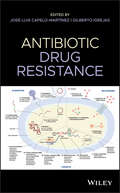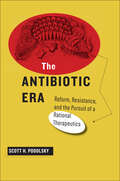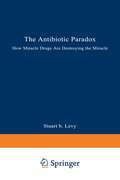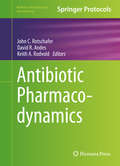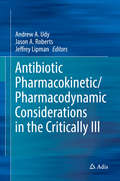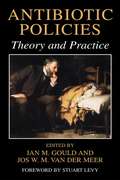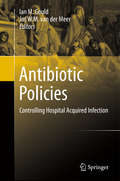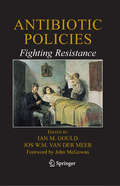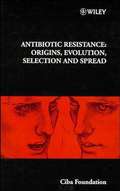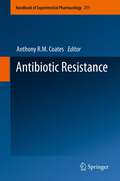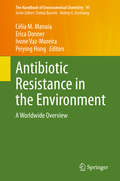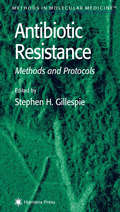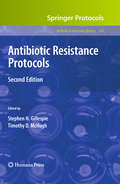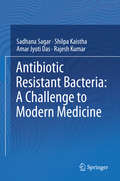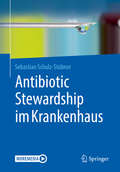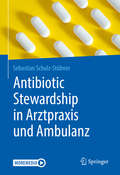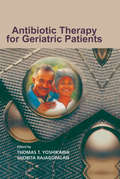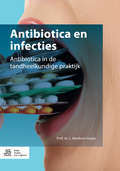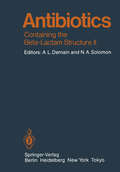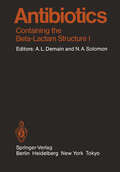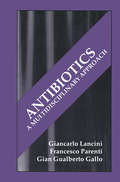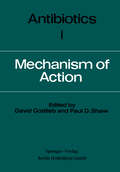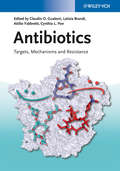- Table View
- List View
Antibiotic Drug Resistance
by José-Luis Capelo-Martínez Gilberto IgrejasThis book presents a thorough and authoritative overview of the multifaceted field of antibiotic science – offering guidance to translate research into tools for prevention, diagnosis, and treatment of infectious diseases. Provides readers with knowledge about the broad field of drug resistance Offers guidance to translate research into tools for prevention, diagnosis, and treatment of infectious diseases Links strategies to analyze microbes to the development of new drugs, socioeconomic impacts to therapeutic strategies, and public policies to antibiotic-resistance-prevention strategies
Antibiotic Drug Resistance
by José‐Luis Capelo‐Martínez Gilberto IgrejasThis book presents a thorough and authoritative overview of the multifaceted field of antibiotic science – offering guidance to translate research into tools for prevention, diagnosis, and treatment of infectious diseases. Provides readers with knowledge about the broad field of drug resistance Offers guidance to translate research into tools for prevention, diagnosis, and treatment of infectious diseases Links strategies to analyze microbes to the development of new drugs, socioeconomic impacts to therapeutic strategies, and public policies to antibiotic-resistance-prevention strategies
The Antibiotic Era: Reform, Resistance, and the Pursuit of a Rational Therapeutics
by Scott H. PodolskyIn The Antibiotic Era, physician-historian Scott H. Podolsky narrates the far-reaching history of antibiotics, focusing particularly on reform efforts that attempted to fundamentally change how antibiotics are developed and prescribed. This sweeping chronicle reveals the struggles faced by crusading reformers from the 1940s onward as they advocated for a rational therapeutics at the crowded intersection of bugs and drugs, patients and doctors, industry and medical academia, and government and the media.During the post–World War II "wonder drug" revolution, antibiotics were viewed as a panacea for mastering infectious disease. But from the beginning, critics raised concerns about irrational usage and overprescription. The first generation of antibiotic reformers focused on regulating the drug industry. The reforms they set in motion included the adoption of controlled clinical trials as the ultimate arbiters of therapeutic efficacy, the passage of the Kefauver-Harris amendments mandating proof of drug efficacy via well-controlled studies, and the empowering of the Food and Drug Administration to remove inefficacious drugs from the market. Despite such victories, no entity was empowered to rein in physicians who inappropriately prescribed, or overly prescribed, approved drugs. Now, in an era of emerging bugs and receding drugs, discussions of antibiotic resistance focus on the need to develop novel antibiotics and the need for more appropriate prescription practices in the face of pharmaceutical marketing, pressure from patients, and the structural constraints that impede rational delivery of antibiotics worldwide. Concerns about the enduring utility of antibioticsâ€�indeed, about a post-antibiotic eraâ€�are widespread, as evidenced by reports from the Centers for Disease Control and Prevention, academia, and popular media alike. Only by understanding the historical forces that have shaped our current situation, Podolsky argues, can we properly understand and frame our choices moving forward.
Antibiotic Pharmacodynamics (Methods in Pharmacology and Toxicology)
by John C. Rotschafer, David R. Andes and Keith A. RodvoldThis text offers state of the art contributions written by world renown experts which provide an extensive background on specific classes of antibiotics and summarize our understanding as to how these antibiotics might be optimally used in a clinical situation. The book explores pharmacodynamics methods for anti-infective agents, pharmacodynamics of antibacterial agents and non-antibacterial agents, as well as pharmacodynamic considerations and special populations. As part of the Methods in Pharmacology and Toxicology series, chapters include detailed insight and practical information for the lab. Comprehensive and cutting-edge, Antibiotic Pharmacodynamics serves as an ideal reference for scientists investigating advances in antibiotic pharmacodynamics now finding their way into the antibiotic development process used for licensing new antibiotics.
Antibiotic Pharmacokinetic/Pharmacodynamic Considerations in the Critically Ill
by Andrew A. Udy Jason A. Roberts Jeffrey LipmanThis book provides unique insights into the issues that drive modified dosing regimens for antibiotics in the critically ill. Leading international authors provide their commentary alongside a summary of existing evidence on how to effectively dose antibiotics. Severe infection frequently necessitates admission to the intensive care unit (ICU). Equally, nosocomial sepsis often complicates the clinical course in ICU. Early, appropriate application of antibiotic therapy remains a cornerstone of effective management. However, this is challenging in the critical care environment, given the significant changes in patient physiology and organ function frequently encountered. Being cognisant of these factors, prescribers need to consider modified dosing regimens, not only to ensure adequate drug exposure, and therefore the greatest chance of clinical cure, but also to avoid encouraging drug resistance.
Antibiotic Policies: Theory and Practice
by Ian M. Gould Jos W. M. Van Der MeerFor 50 years, antibiotics have been dispensed like sweets. This must not be allowed to continue. This unique book assembles contributions from experts around the world concerned with responsible use of antibiotics and the consequences of overuse. For the first time, it provides up to the minute texts on both the theoretical aspects of antibiotic stewardship and the practical aspects of its implementation, with consideration of the key differences between developed and developing countries. All concerned with teaching, practice and administration of clinical medicine, surgery, pharmacy, public health, clinical pharmacology, microbiology, infectious diseases and clinical therapeutics will find Antibiotic Policies: Theory and Practice essential reading. Antibiotic use and resistance is not just the responsibility of specialists in the field but the responsibility of all doctors, pharmacists, nurses, healthcare administrators, patients and the general public.
Antibiotic Policies: Controlling Hospital Acquired Infection
by Ian M. Gould and Jos W.M. MeerThe first book was on "Theory and Practice" of antibiotic stewardship in its broadest sense -the how to do it and the do's and don’ts. The second, on "Controlling resistance" was very much on the relationships between use and resistance and beginning to home in on the hospital as the main generator of resistance, but mainly looking at it from a disease/clinical perspective. The last 3 chapters on MRSA, ended where the 3rd book will take off. "Controlling HAI " will concentrate on specific MDR organisms highlighting their roles in the current pandemic of HAI and emphasizing that the big issue is not so much infection control but antibiotic control, in the same way that antibiotic over-reliance/ over-use has caused the problem in the first place. Up 'till now the emphasis for controlling MRSA, C diff and all the other MDROs has very much been on IC, which clearly isn't working. This book will gather all the evidence for the increasingly popular view that much more must be done in the area of antibiotic policies/ stewardship, especially when we are in danger of a "post antibiotic" era, due to a real shortage of new agents in the pipeline.
Antibiotic Policies: Fighting Resistance
by Ian M. Gould Jos W. M. Van Der MeerThis volume examines many of the crucial issues of resistance in a clinical context, with an emphasis on MRSA; surely the greatest challenge to our antibiotic and infection control policies that modern health care systems have ever seen. Other chapters explore the psychology of prescribing, modern management techniques as an adjunct to antibiotic policies, and the less obvious downsides of antibiotic use.
Antibiotic Resistance: Origins, Evolution, Selection and Spread (Novartis Foundation Symposia #207)
by Derek J. Chadwick Jamie A. GoodeAntibiotic Resistance: Origins, Evolution, Selection and SpreadChairman: Stuart B. Levy, 1997 Over the last 50 years, the rapid increase in the use of antibiotics, not only in people, but also in animal husbandry and agriculture, has delivered a selection unprecedented in the history of evolution. Consequently, society is facing one of its gravest public health problems-the emergence of infectious bacteria with resistance to many, and in some cases all, available antibiotics. This book brings together a multidisciplinary group of experts to discuss this problem. It begins by examining the origins of resistance and goes on to look at how the use of antibiotics in human medicine and farming/agriculture has selected for resistant bacteria. Separate chapters describe the evolution of resistance determinants and how these are spread both within and between bacterial species. Finally, the book contains discussions on strategies for countering the threat of antibiotic resistance. A major re-thinking of our approach to the treatment of infectious diseases is proposed-that antibiotic resistance should be seen as a problem created by the disruption of normal microbial ecology. To restore efficacy to earlier antibiotics, and to maintain the success of new antibiotics that are introduced, we need to use these drugs in a way that ensures an ecological balance that favours the predominance of susceptible bacteria.
Antibiotic Resistance (Handbook of Experimental Pharmacology #211)
by Anthony R. M. CoatesThis book describes antibiotic resistance amongst pathogenic bacteria. It starts with an overview of the erosion of the efficacy of antibiotics by resistance and the decrease in the rate of replacement of redundant compounds. The origins of antibiotic resistance are then described. It is proposed that there is a large bacterial resistome which is a collection of all resistance genes and their precursors in both pathogenic and non-pathogenic bacteria. Ongoing resistance surveillance programs are also discussed, together with the perspective of a clinical microbiologist. The book then turns to specific themes such as the most serious area of resistance in pathogens, namely in Gram-negative organisms. The role of combinations of antibiotics in combating resistance emergence is discussed, particularly in the tuberculosis field, and then the importance of non-multiplying and persistent bacteria which are phenotypically resistant to antibiotics and prolong the duration of therapy of antibiotics which leads to poor compliance and resistance emergence. The role of anti-microbial compounds in textiles is covered, with its potential to exacerbate the spread of resistance. Then, efflux pumps are discussed. The final chapter describes the compounds which are in late stage clinical development, illustrating the paucity of the antibiotic pipeline, especially for Gram-negative bacteria.
Antibiotic Resistance in the Environment: A Worldwide Overview (The Handbook of Environmental Chemistry #91)
by Célia M. Manaia Erica Donner Ivone Vaz-Moreira Peiying HongThis book provides a multidisciplinary review of antibiotic resistance and unravels the complex and interrelated roles of environmental sources, including pharmaceutical industry effluents, hospital and domestic effluents, wildlife and drinking water. Antibiotic resistance is a global public health issue in which the interface between humans, animals and the environment is particularly relevant. The contrasts seen across different environmental compartments and world regions, which are due to climate, social and policy differences, mean that this problem needs to be analyzed from a multi-geographic and multi-cultural angle. Bringing together contributions from researchers on different continents with expertise in antibiotic resistance in a range of different environmental compartments, the book offers a detailed reflection on the paths that make antibiotic resistance a global threat, and the state-of- the-art in antibiotic resistance surveillance and risk assessment in complex environmental matrices.
Antibiotic Resistance Methods and Protocols: Methods And Protocols (Methods in Molecular Medicine #48)
by Stephen H GillespieAntibiotic Resistance Protocols: Second Edition (Methods in Molecular Biology #642)
by Stephen H. Gillespie and Timothy D. McHughSince the publication of the popular first edition, genomic methods have become more accessible, allowing antibiotic researchers to probe not only the sequence of antibiotic resistance determinants but the mechanism whereby they are expressed and regulated. That, in concert with array technology and an understanding of the importance of biofilms, has greatly expanded antibiotic resistance knowledge. In order to reflect the growing field, Antibiotic Resistance Protocols, Second Edition fully updates and builds upon its first edition with contributions from leading researchers. Beginning with chapters on epidemiology and population genetics, the book continues with sections covering genomics and gene expressions, fitness mutation and physiology, and the detection of resistance. Written in the highly successful Methods in Molecular Biology™ series format, chapters include introductions to their respective topics, lists of the necessary materials and reagents, step-by-step, readily reproducible laboratory protocols, and notes on troubleshooting and avoiding known pitfalls. Authoritative and up-to-date, Antibiotic Resistance Protocols, Second Edition brings together examples of a diverse range of modern techniques applied in antibiotic research in order to best aid scientists in planning their own future research.
Antibiotic Resistant Bacteria: A Challenge to Modern Medicine
by Rajesh Kumar Amar Jyoti Das Sadhana Sagar Shilpa KaisthaThis book summarizes the emerging trends in the field of antibiotic resistance of various gram-negative and gram-positive bacterial species. The ability of different species of bacteria to resist the antimicrobial agent has become a global problem. As such, the book provides a comprehensive overview of the advances in our understanding of the origin and mechanism of resistance, discusses the modern concept of the biochemical and genetic basis of antibacterial resistance and highlights the clinical and economic implications of the increased prevalence of antimicrobial resistant pathogens and their ecotoxic effects. It also reviews various strategies to curtail the emergence and examines a number of innovative therapeutic approaches, such as CRISPR, phage therapy, nanoparticles and natural antimicrobials, to combat the spread of resistance.
Antibiotic Stewardship im Krankenhaus
by Sebastian Schulz-StübnerExpertenwissen zum rationalen Einsatz von Antiinfektiva im Krankenhaus ist unverzichtbar. Antibiotic Stewardship zur optimalen Behandlung von Infektionen und zur Bekämpfung von Antibiotikaresistenzen. Spezielle Strategien und ihre Umsetzung im Alltag zur Verbesserung der Patientensicherheit.Der Leitfaden für „Antibiotikabeauftragte Ärzte“ und die modularen Fortbildungen (fellow-, advanced- und expert-Kurs) zu „Antibiotic Stewardship“.Aus dem InhaltEpidemiologie, Bewertung von Resistenzstatistik und Antibiotikaverbrauch, Surveillancesysteme und BenchmarkingGesetzliche Grundlagen: Infektionsschutzgesetz, gesetzliche Qualitätssicherung, ArzneimittelrechtOralisierungsstrategien und Outpatient parenteral antibiotic therapy (OPAT), Dosisoptimierung und Therapeutisches Drugmonitoring (TDM)Diagnostic Stewardship, Bewertung mikrobiologischer BefundePerioperative Antibiotikaprophylaxe und InfektionsmanagementAntibiotikaprophylaxen bei Immunsuppression und chronischen KrankheitenDie wichtigsten Krankheitsbilder unter ABS-GesichtspunktenPädiatrische BesonderheitenEinbeziehung von Ärzten, Pflegenden, Patienten und Angehörigen. Entlass- und ÜberleitungsmanagementFallbeispiele aus der ABS-Beratung
Antibiotic Stewardship in Arztpraxis und Ambulanz
by Sebastian Schulz-StübnerExpertenwissen zum rationalen Einsatz von Antiinfektiva in Arztpraxis und Ambulanz ist unverzichtbar. Bekämpfung von Antibiotikaresistenzen. Spezielle Strategien und ihre Umsetzung im Alltag.Für jede Praxis und jedes ambulante OP-Zentrum, wo Antibiotika angewendet und verschrieben werden. Insbesondere für die Fortbildung zum „Antibiotikabeauftragten Arzt“.Aus dem InhaltEpidemiologie, Bewertung von Resistenzstatistik und Antibiotikaverbrauch, Surveillancesysteme und BenchmarkingGesetzliche Grundlagen: Infektionsschutzgesetz, gesetzliche Qualitätssicherung, ArzneimittelrechtOutpatient parenteral antibiotic therapy (OPAT), Dosisoptimierung und Therapeutisches Drugmonitoring (TDM)Diagnostik: Präanalytik und Probenversand, Point of Care Tests (POCT)Wann ist eine mikrobiologische Untersuchung erforderlich, Bewertung des BefundesDie wichtigsten Krankheitsbilder unter ABS-GesichtspunktenImpfungen, pädiatrische Besonderheiten, Antibiotika in Schwangerschaft und StillzeitEinbeziehung von Patienten und Angehörigen. Was ist zu tun, wenn der Patient aus der Klinik kommtChoosing wisely: Wann benötigen Sie keine Antibiotika in der Hausarztpraxis oder im ärztlichen NotfalldienstFallbeispiele aus der ABS-Beratung
Antibiotic Therapy for Geriatric Patients
by Thomas T. Yoshikawa Shobita RajagopalanWritten by the foremost authorities on the topic, this reference provides quick access to essential information on specific antibiotics, major clinical infections, selected pathogens, and infections in long-term elderly-care facilities-summarizing the vast array of topics related to infectious diseases in older adults including epidemiology, clinic
Antibiotica en infecties: Antibiotica in de tandheelkundige praktijk
by L. Abraham-InpijnHet duel tussen antimicrobiële middelen en micro-organismen is er één dat al jaren de wetenschap bezighoudt. Hierover werd in de zestiger jaren van de vorige eeuw nog gezegd dat: ‘in 2000 er geen infectieziekten meer zijn’. De strijd dreigt nu te eindigen met een overwinning door de micro-organismen. De negatieve spiraal die is ontstaan wordt onder meer versterkt door: overmatig en ondeskundige antibioticagebruik (zowel in de humane als veterinaire geneeskunde), gebrek aan innovatie met betrekking tot nieuwe antimicrobiële middelen en de grote mobiliteit in vracht en personenvervoer. Dit alles naast vakantiereizen, immigratie, ongezonde levensomstandigheden en <andere externe factoren. Aanpassing van het beleid omtrent gebruik van antibiotica is hierdoor noodzakelijk geworden. Dit boek gaat in op de veranderende visie ten aanzien van het gebruik van antibiotica. Welke oorzaken liggen hieraan ten grondslag en wat zijn de consequenties? Ook de indicaties waarover in de tandheelkunde nog discussies bestaan komen aan de orde. Daarnaast biedt het een op de wetenschappelijke literatuur gefundeerd antwoord op praktische vragen over het gebruik van antibiotica in de tandheelkundige praktijk. Antibiotica en infecties is een onmisbaar boek bij het gebruik van antibiotica en profylaxe in de tandheelkunde. Deze uitgave is primair geschreven voor tandartsen en overige (tandheelkundige) professionals die te maken krijgen met gebruik van antibiotica in hun praktijk. De auteur prof. Dr. L. Abraham-Inpijn is emeritus hoogleraar inwendige geneeskunde en algemene pathologie aan de faculteit geneeskunde UvA, mede ten behoeve van de tandheelkunde. Tot op heden is zij verbonden aan de Divisie A (Interne Geneeskunde) van het Amsterdams Medisch Centrum. Zij heeft verschillende publicaties op haar naam staan en schrijft regelmatig artikelen voor het vakblad voor de tandarts ‘Tandartspraktijk’.
Antibiotics: Containing the Beta-Lactam Structure Part II (Handbook of Experimental Pharmacology #67 / 2)
by P. Actor M. C. Browning N. H. Georgopapadakou J.R.E. Hoover K. C. Kwan A. K. Miller J. D. Rogers R. B. Sykes B. M. Tune J. V. UriAntibiotics: Containing the Beta-Lactam Structure (Handbook of Experimental Pharmacology #67 / 1)
by Arnold L. Demain Nadine A. SolomonAntibiotics: A Multidisciplinary Approach
by G.G. Gallo G. Lancini F. ParentiIn this translation of the Italian second edition, the authors provide a comprehensive account of the current knowledge on antibiotics. They concisely describe how various scientific disciplines are involved in antibiotics research, development, and use. Their work also discusses the industrial and clinical development of new antibiotics, as well as the questions and controversies related to the function of antibiotics in nature. Antibiotics is richly illustrated with clear chemical structures, drawings, diagrams, and synoptical tables.
Antibiotics: Targets, Mechanisms and Resistance
by Claudio O. Gualerzi Letizia Brandi Attilio Fabbretti Cynthia L. PonMost of the antibiotics now in use have been discovered more or less by chance, and their mechanisms of action have only been elucidated after their discovery. To meet the medical need for next-generation antibiotics, a more rational approach to antibiotic development is clearly needed. Opening with a general introduction about antimicrobial drugs, their targets and the problem of antibiotic resistance, this reference systematically covers currently known antibiotic classes, their molecular mechanisms and the targets on which they act. Novel targets such as cell signaling networks, riboswitches and bacterial chaperones are covered here, alongside the latest information on the molecular mechanisms of current blockbuster antibiotics. With its broad overview of current and future antibacterial drug development, this unique reference is essential reading for anyone involved in the development and therapeutic application of novel antibiotics.
Antibiotics: Targets, Mechanisms and Resistance
by Claudio O. Gualerzi Letizia Brandi Attilio Fabbretti Cynthia L. PonMost of the antibiotics now in use have been discovered more or less by chance, and their mechanisms of action have only been elucidated after their discovery. To meet the medical need for next-generation antibiotics, a more rational approach to antibiotic development is clearly needed. Opening with a general introduction about antimicrobial drugs, their targets and the problem of antibiotic resistance, this reference systematically covers currently known antibiotic classes, their molecular mechanisms and the targets on which they act. Novel targets such as cell signaling networks, riboswitches and bacterial chaperones are covered here, alongside the latest information on the molecular mechanisms of current blockbuster antibiotics. With its broad overview of current and future antibacterial drug development, this unique reference is essential reading for anyone involved in the development and therapeutic application of novel antibiotics.
